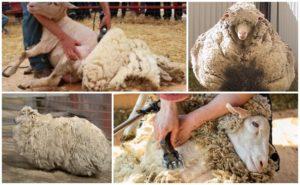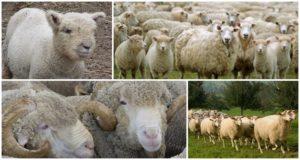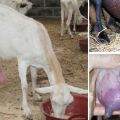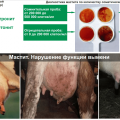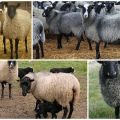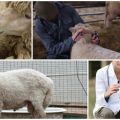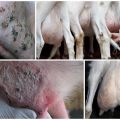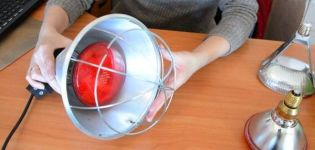Types and symptoms of mastitis in sheep, home treatment and prevention
Breast disease (mastitis) is widespread in small ruminants. As a rule, mastitis appears in sheep a month and a half after lambing. The damage from the disease is expressed in a decrease in the milk, meat, wool productivity of animals. If treatment is not promptly started, mastitis can lead to the death of lambs and females. To accurately diagnose, a clinical examination of the mammary glands of the uterus, a laboratory study of milk is required.
Causes of the disease
The peak of mastitis usually occurs in May-July. The causes of the onset of the disease can be conditionally divided into two groups:
- infectious - mastitis is caused by microorganisms (mainly staphylococci, streptococci) that enter the body through the nipple canal with injuries of the mammary glands, nipples. The appearance of infections is facilitated by dirty bedding, unwashed hands of the milkmaid, dirty water, which was used to wash the udder;
- non-infectious - the causes of mastitis are udder injuries (injections, bruises), cracked nipples, hypothermia, chemical factors (treatment of the udder with special means).
Massive diseases of sheep with mastitis provoke difficult weather conditions (sharp cold snap, prolonged rains). In case of death of lambs, there is a possibility of termination of lactation in the ewe, which can also provoke mastitis.
Types and symptoms
The disease in ewes is mostly acute. Several forms of the disease are observed:
- for catarrhal mastitis is characterized by decreased appetite, increased respiration, pulse rate, increased body temperature. Milk becomes watery, bluish or yellowish. If you do not start to treat in time, mastitis becomes hemorrhagic;
- with serous mastitis, there is a lack of appetite, the animal does not move well (lameness on the hind legs may appear), females do not allow lambs to approach the udder. Without the provision of drug assistance, after a day, mastitis turns into a purulent-catarrhal form;
- purulent catarrhal mastitis is manifested by a lack of appetite, high body temperature, and an increase in the size of the udder. The animal predominantly lies, lameness is observed when walking.

The most difficult is hemorrhagic mastitis, leading to gangrene of the udder and even death of the animal. Symptoms of the disease: the inflamed part of the udder swells, the skin turns reddish-purple. Flakes are present in pinkish or red milk. Ewes usually die after 2-4 days.
Diagnosis of mastitis
Inspection of sheep begins with an assessment of the general condition: they measure the pulse, body temperature, and assess respiration. To make a diagnosis, the udder is carefully palpated. During a visual examination, the appearance of the udder, shape, color of the skin and the presence of skin diseases are assessed, and traces of damage or injury are detected.
How to treat mastitis in a sheep
The danger of mastitis is to provoke irreversible processes in the tissues. Early diagnosis, timely treatment started significantly increase the effectiveness of treatment, shorten the recovery time.
Medicines
For the treatment of sick animals, mainly antimicrobial drugs (antibiotics, sulfonamides) are used. In this case, you need to take into account the nuances of each treatment method:
- intramuscular injection of norsulfazole three times a day. Once a day, penicillin, streptomycin is injected into the affected lobe of the udder through the nipple. Disadvantages of the method - the administration of drugs is laborious, it is necessary to carry out manipulations several times a day;
- practice intramuscular administration of bicillin-3, which is characterized by prolonged action. The main disadvantage of the treatment is that sometimes there is poor efficiency;
- a common method is rubbing tylosin-based ointments into the diseased part of the udder. The negative side of the treatment is laboriousness (the animal must first be fixed, and then patiently rub the ointment into the nipples).
A good result is observed with complex treatment, when injections of various drugs are combined, rubbing ointments into the udder or nipples. It is also advisable to use physiotherapy - warming compresses, UV lamp irradiation, udder massage.
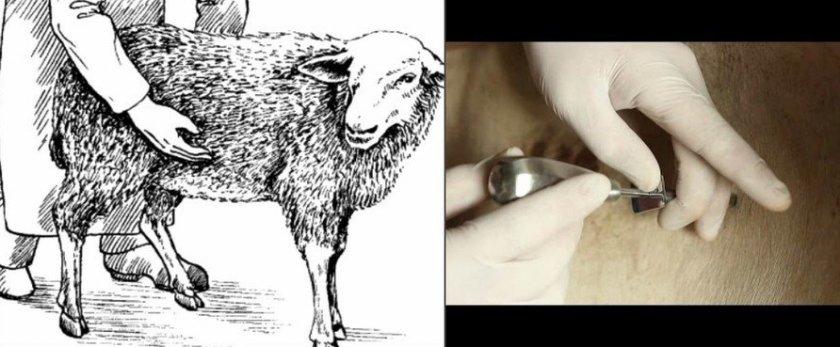
Traditional methods
Home treatment for latent mastitis in sheep is possible in several ways. Medicinal herbs, fresh and baked vegetables, dairy products are used. Popular options:
- cabbage leaf, grated carrot cake is applied to the affected area of the udder. Vegetables relieve pain, relieve swelling and eliminate inflammation;
- vodka compresses are used to combat abscesses;
- grated beets mixed with honey are applied to the cracks. Keep the mixture in the cold, and the treatment is continued for 14-20 days;
- A kind of ointment for the treatment of injuries, purulent inflammation, edema is made from lard. Dried calendula is added to the melted fat;
- popular recipe with baked onions. Milk and kombucha are added to the gruel from pounded onions. The mixture of components is used in the form of a compress with antibacterial qualities.
The advantage of traditional medicine recipes is the absence of harm to the animal's body. But it must be borne in mind that infectious mastitis cannot be cured in such ways.

Potential danger
Individuals with chronic or purulent mastitis should not be left on the farm, since the disease can drag on for a long period. In this case, the infection will spread among healthy sheep.
It should also be borne in mind that in case of recovery from infectious mastitis, the milk productivity of sheep is practically not restored.
We must not forget that during the period of treatment of sheep, milk should not be consumed, since it will contain not only infection, but also antibiotics. Such milk should not be given to lambs. Therefore, during the period of treatment, the cubs are not allowed near the uterus.
Preventive actions
First of all, prevention should be aimed at preventing the appearance of diseases. Common measures:
- compliance with the standards of keeping and feeding animals, caring for them;
- for ewes, special boxes are fenced off, where places are provided for newborn lambs;
- sick sheep must be isolated in separate rooms, which are regularly disinfected;
- observance of milking hygiene.
Sick animals that do not respond to treatment are discarded. Also, you should not leave ewes who have fallen ill with mastitis several times during lactation. In order not to develop severe forms of mastitis, treatment is started when the first signs appear. The main goals of the prevention and treatment of mastitis are to create conditions for animals aimed at increasing the protective abilities of the body. It is also important to eliminate the causes that contribute to the occurrence of infections. It is recommended that you check your ewes regularly to avoid overlooking dangerous symptoms.
